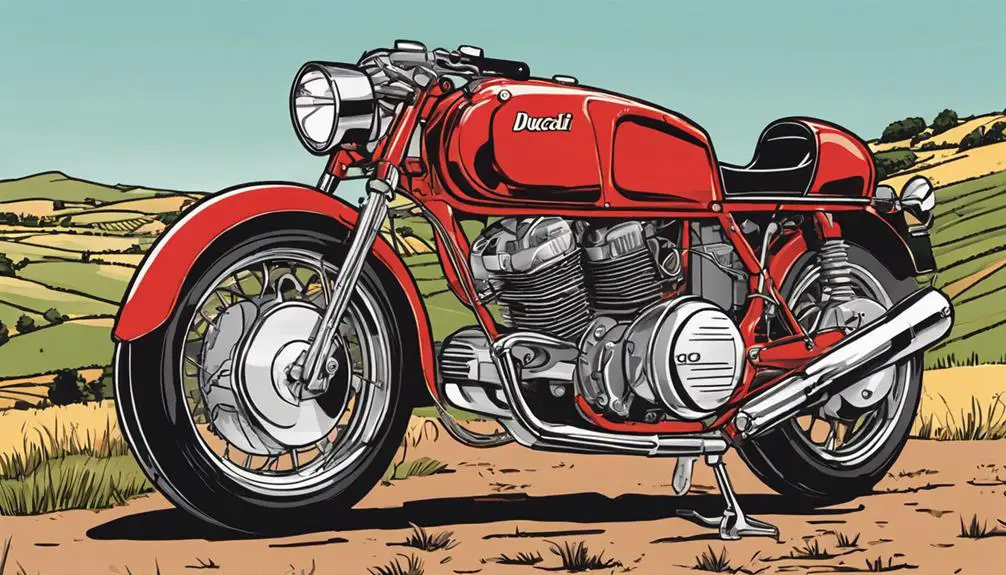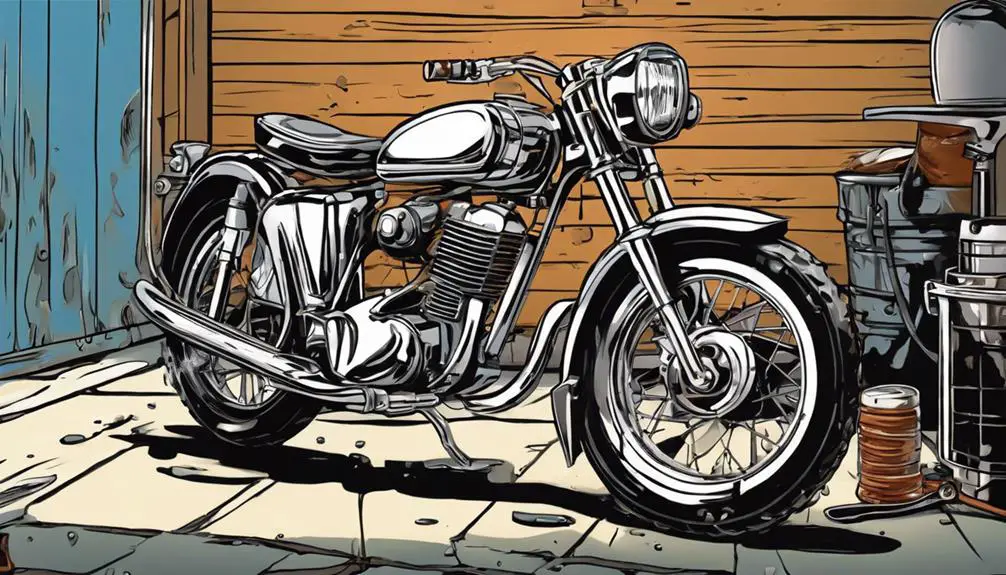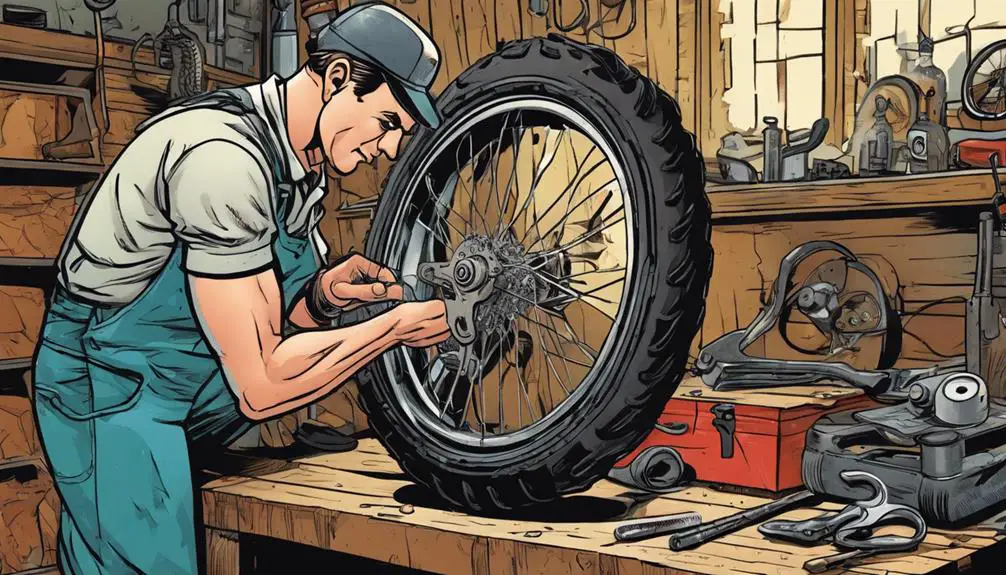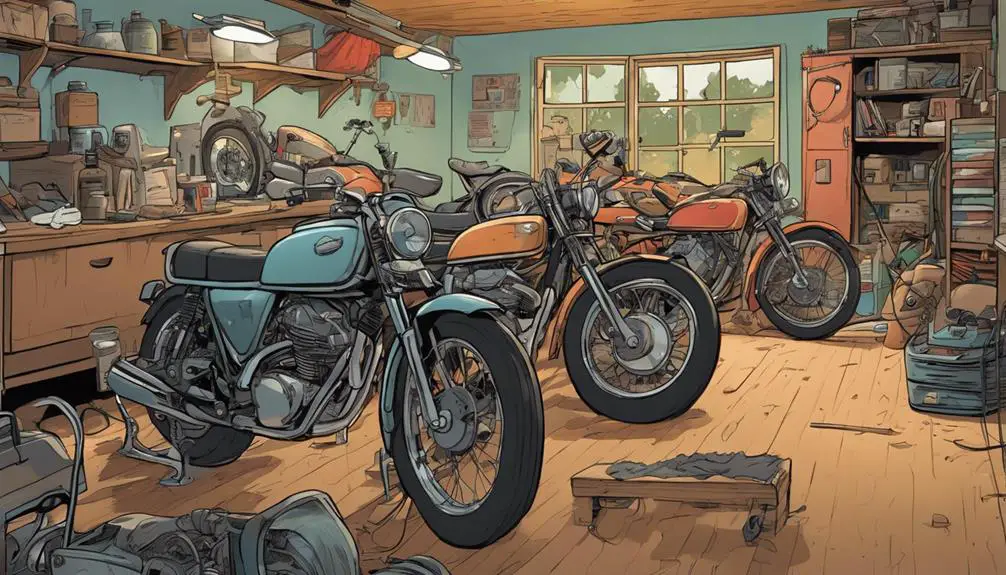Maintaining classic bikes is like tending to a vintage garden; both require patience and meticulous care to thrive. You might wonder what specific practices can keep your bike in prime condition for years to come. From regular inspections to proper cleaning techniques, there's a wealth of knowledge that can make a significant difference. Understanding the nuances of engine maintenance and tire care is vital, but what about the often-overlooked storage solutions that can prevent deterioration? Let's explore these essential practices that every classic bike owner should know.
Key Takeaways
- Perform regular inspections on critical components like tires, brakes, and chains to ensure safety and optimal performance.
- Keep the engine well-maintained with frequent oil changes and fuel system checks to prevent wear and maintain efficiency.
- Clean and protect the bike using proper techniques, ensuring surfaces are free from dirt and contaminants to avoid damage.
- Store the bike in a controlled environment, using breathable covers and elevating tires to prevent flat spots and rust formation.
Understanding Ducati Heritage

To truly appreciate classic Ducati bikes, you need to understand the rich heritage that shapes their iconic design and performance. Founded in 1926, Ducati's journey began with a commitment to innovation and speed, values that resonate deeply with riders seeking freedom on the open road. Each model you encounter isn't just a machine; it's a representation of decades of engineering excellence and a passion for performance.
Ducati's bold designs and powerful engines reflect an ethos of liberation. The brand's iconic L-twin engine, for instance, delivers an exhilarating experience that invites you to break free from the mundane. You can feel the adrenaline rush as you twist the throttle, embracing the wind as you navigate twists and turns.
Moreover, Ducati's racing pedigree, with victories in MotoGP and World Superbike, fuels your desire for adventure. It connects you to a global community of enthusiasts who share your passion for speed and craftsmanship. Understanding this heritage empowers you to appreciate not just the bike, but the spirit of rebellion and liberation it embodies.
Immerse yourself in the Ducati experience—let its legacy inspire your journey on two wheels.
Regular Inspection Routines
Regular inspections are essential for keeping your classic bike in top shape and guaranteeing a safe riding experience. You should set aside time every month to check critical components.
Start with the tires—look for wear and verify they're properly inflated. Next, inspect the brakes. Squeeze the levers and check for responsiveness; replace worn pads to maintain stopping power.
Don't overlook the chain and gears. Lubricate the chain regularly and check for slack or damage. A well-maintained chain will enhance your bike's performance and longevity.
Also, take a moment to examine the lights and signals. Visibility is key to freedom on the road, so make certain everything's functioning properly.
Pay attention to fluid levels, too. Check the oil, coolant, and brake fluid to ascertain they're at the right levels. Low fluids can lead to engine trouble or brake failure, and that's the last thing you want.
Proper Cleaning Techniques

Keeping your classic bike clean plays an essential role in preserving its appearance and functionality, especially after you've inspected it for any issues.
Start by gathering your cleaning supplies: a bucket, mild soap, a soft sponge, microfiber cloths, and a brush for hard-to-reach areas.
Begin by rinsing your bike with water to remove loose dirt.
Apply the soap with the sponge, moving in gentle, circular motions. This helps lift grime without scratching the surface. Pay special attention to intricate parts like the chain and gears, where dirt tends to accumulate.
After washing, rinse thoroughly to guarantee no soap residue remains, as this can attract more dirt.
Dry your bike with a microfiber cloth to prevent water spots and corrosion.
Don't forget to clean your tires! Use a separate brush to scrub away any debris, ensuring ideal grip on your rides.
Engine Maintenance Essentials
When it comes to keeping your classic bike in top shape, engine maintenance is essential.
You need to stay on top of regular oil changes and inspect the fuel system to guarantee everything runs smoothly.
Ignoring these essentials can lead to bigger issues down the road.
Regular Oil Changes
Consistent oil changes are essential for ensuring your classic bike's engine runs smoothly and efficiently. You might think skipping this task is harmless, but neglecting oil changes can lead to engine wear and costly repairs. Aim to change the oil every 1,000 to 3,000 miles, depending on your bike's specific needs and how you ride.
When you change the oil, don't just focus on the oil itself; use a high-quality filter to catch impurities. Regularly check the oil level and quality, too. If it's dark and gritty, it's time for a change.
Remember, your bike is more than a machine; it's an extension of your freedom. Treating it with respect and care allows you to break free from the mundane and embrace the open road.
Don't hesitate to get your hands dirty. Performing oil changes yourself can be empowering and deepen your connection to your bike. Plus, it gives you the chance to inspect other engine components.
Inspect Fuel System
Regularly inspecting your fuel system is essential for keeping your classic bike running smoothly and efficiently. Fuel is the lifeblood of your ride, and a healthy system guarantees you have the freedom to explore the open road without fear.
Start by checking for leaks in the fuel lines, as even a small crack can lead to significant issues. Use a flashlight to inspect the fuel tank for rust or debris that might clog the fuel filter.
Don't forget to examine the fuel filter itself. If it's dirty or clogged, you're risking poor performance and potential engine damage. Replace it if necessary.
Next, consider the fuel quality; using fresh fuel can prevent problems associated with stale gas. If you've let your bike sit for a while, drain any old fuel and refill with fresh premium gasoline.
Tire Care and Replacement

Maintaining your classic bike's tires is essential for safety and performance, so check their condition frequently. The tires are your only contact with the road, and a small issue can lead to big problems. Here are some key practices to keep in mind:
- Inspect Tread Depth: Regularly check the tread. If it's worn down, you'll lose grip, impacting your ride and safety. Replace tires when the tread shows significant wear.
- Look for Cracks and Bulges: A visual inspection can reveal cracks or bulges that indicate tire damage. These defects can lead to blowouts, so replace any compromised tires immediately.
- Check Air Pressure: Keeping your tires properly inflated is vital. Under-inflated tires can cause poor handling and increase the risk of flats. Use a gauge to check pressure weekly and inflate as needed.
Electrical System Checks
To guarantee your classic bike runs smoothly, you'll want to frequently check the electrical system for any signs of wear or malfunction.
Start by inspecting the battery. Make sure it's secure, clean, and charged. Corrosion can sneak in, so wipe down the terminals with a solution of baking soda and water if you see any buildup.
Next, examine the wiring. Look for frayed or cracked insulation that could lead to shorts or intermittent connections.
Don't forget the fuses! A blown fuse can disrupt your ride, so keep spares on hand and replace any faulty ones immediately.
Check your lights and indicators too; they're essential for safety and visibility.
Storage Tips for Longevity

Proper storage can greatly extend the life of your classic bike, ensuring it remains in peak condition for years to come. When you're not riding, it's crucial to create an environment that protects your bike from the elements and potential damage.
Here are three key storage tips you should follow:
- Choose a Dry, Climate-Controlled Space: Store your bike in a garage or shed that's shielded from moisture and extreme temperatures. This helps prevent rust and deterioration.
- Use a Quality Cover: Invest in a breathable cover to protect your bike from dust and scratches. Avoid plastic, as it can trap moisture, leading to corrosion.
- Elevate Your Tires: If possible, use a bike stand or place your bike on a soft surface to prevent flat spots on your tires. This simple step can prolong tire life and keep your bike ready for action.
Frequently Asked Questions
How Often Should I Replace My Classic Bike's Oil?
You should replace your classic bike's oil every 3,000 miles or at least once a year, whichever comes first.
Regular oil changes keep your engine running smoothly and extend its lifespan.
Don't wait for signs of trouble; staying proactive gives you the freedom to ride without worry.
Check your oil levels periodically, and make it a part of your routine maintenance.
Embrace that liberation, knowing your bike's in top shape!
What Type of Fuel Is Best for Classic Bikes?
When it comes to fueling your classic bike, you'll want to stick with high-octane gasoline, preferably 91 octane or higher. This helps prevent knocking and guarantees peak performance.
Avoid ethanol blends, as they can damage older fuel systems and lead to corrosion.
You might also consider using a fuel stabilizer to keep your fuel fresh, especially if you're not riding regularly.
Choosing the right fuel keeps your ride smooth and liberates your biking experience!
Are Aftermarket Parts Advisable for Classic Bike Restoration?
Are aftermarket parts worth the risk for your classic bike restoration?
While they can offer affordability and availability, you've got to take into account quality and authenticity.
Cheap parts might compromise the bike's integrity and value, so it's essential to research brands and materials.
You want your ride to reflect its original glory, don't you?
Opting for reputable aftermarket options can strike a balance between practicality and preserving that classic spirit.
Choose wisely!
How Can I Identify Rust on My Classic Bike?
To identify rust on your classic bike, start by inspecting the frame, handlebars, and other metal components for any discoloration or rough patches.
Don't forget to check hidden areas, like under the seat or inside the fenders.
Use a magnet to test for rust; it won't stick to rusted areas.
If you find rust, don't panic—address it promptly to keep your bike in top shape and enjoy your ride to the fullest!
What Tools Are Essential for Basic Classic Bike Maintenance?
For basic classic bike maintenance, you'll need a few essential tools.
Grab a good set of wrenches, screwdrivers, and pliers, as they'll help you tackle most repairs.
A tire pump and patch kit are vital for keeping your tires in top shape.
Don't forget a chain cleaner and lubricant to keep your ride smooth.
With these tools, you can unlock your bike's potential and enjoy the freedom of the open road!
Conclusion
By following these best practices, you can keep your classic bike running like a well-oiled machine.
It's all about being proactive, from regular inspections to proper cleaning and maintenance.
Don't let neglect turn your pride and joy into a rusty relic.
With a little care and attention, you'll not only preserve its beauty but also guarantee it rides smoothly for years to come.
So, get in the saddle and keep your vintage ride in tip-top shape!